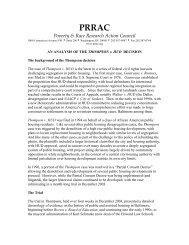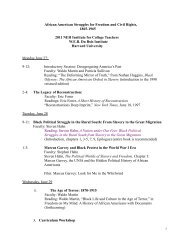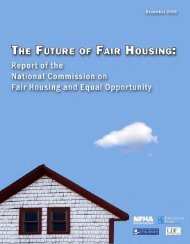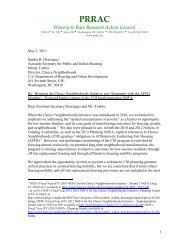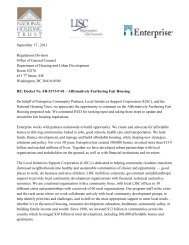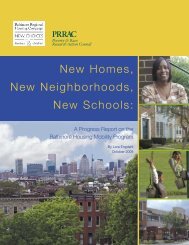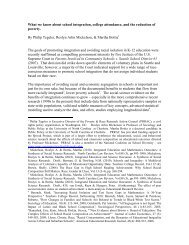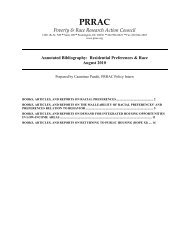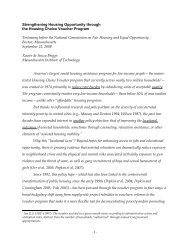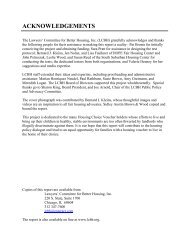Annotated Bibliography of Housing Mobility Research 2006-2010
Annotated Bibliography of Housing Mobility Research 2006-2010
Annotated Bibliography of Housing Mobility Research 2006-2010
Create successful ePaper yourself
Turn your PDF publications into a flip-book with our unique Google optimized e-Paper software.
Climaco, Carissa G., Christopher N. Rodger, Judith D. Feins & Ken Lam, “Portability Moves<br />
in the <strong>Housing</strong> Choice Voucher Program, 1998–2005,” Cityscape 10(1): 540 (2008)<br />
Abstract:<br />
Reports the results from a study on the household and neighborhood characteristics associated<br />
with portability moves in the HCVP from 1998 to 2005. Of the 3.4 million households that<br />
received housing assistance in the voucher program from 1998 to 2005, 8.9% made a portability<br />
move. The rate <strong>of</strong> portability movers was highest among AfricanAmerican households (10.3%)<br />
compared with White households (8.1%) and Hispanic households (8.6%). Compared with<br />
households in the HCVP overall, portability movers are more likely to comprise households with<br />
young children and more likely to have a younger head <strong>of</strong> household. Length <strong>of</strong> stay in the HCVP<br />
is correlated with portability moves, and portability moves are most likely to occur between the<br />
fourth and fifth years <strong>of</strong> HCVP participation. When examining public housing jurisdictions by<br />
program costs, threefifths <strong>of</strong> portability moves were made to lower cost jurisdictions compared<br />
with the originating jurisdiction. The data also show reductions in census tract poverty rates and<br />
other neighborhood indicators for households that completed portability moves.<br />
Comey, Jennifer, Xavier de Souza Briggs & Gretchen Weismann, “Struggling to Stay Out <strong>of</strong><br />
HighPoverty Neighborhoods: Lessons from the Moving to Opportunity Experiment,” Urban<br />
Institute (2008)<br />
Abstract:<br />
Uses data from the ThreeCity Study <strong>of</strong> MTO to explore the mobility patterns <strong>of</strong> MTO<br />
experimentalgroup and Section 8 comparisongroups families and the factors that influenced their<br />
moves. Finds that the main reasons for subsequent moves were lease problems, conflicts with a<br />
landlord, and wanting a bigger or betterquality apartment. Discusses trade<strong>of</strong>fs faced by MTO<br />
families between a decent neighborhood, a decent apartment, a job, or a reliable support network<br />
(i.e. a source <strong>of</strong> free childcare from a loved one) when considering subsequent moves.<br />
Recommends a reinvigorated supplyside strategy focused on inclusion <strong>of</strong> affordable housing in<br />
nondistressed areas and improved administration <strong>of</strong> the voucher program, including housing<br />
search assistance, landlord outreach, and ongoing relocation counseling for families that must<br />
make subsequent moves. Suggests that transportation strategies (i.e. “car vouchers”) could<br />
mitigate some neighborhood trade<strong>of</strong>fs.<br />
Cove, Elizabeth, Xavier de Souza Briggs, Margery Austin Turner & Cynthia Duarte, “Can<br />
Escaping from Poor Neighborhoods Increase Employment and Earnings Metropolitan<br />
<strong>Housing</strong> and Communities Center,” Urban Institute (2008)<br />
Abstract:<br />
Reviews findings on MTO’s impacts on employment to date and findings from the ThreeCity<br />
Study <strong>of</strong> MTO. Finds no significant correlation between exposure to racially integrated, low<br />
poverty areas and employment outcomes, as the results were mixed. Finds that moving away from<br />
poor, inner city neighborhoods to a less poor area did not bring greater proximity to job<br />
opportunities and, for some families, it meant leaving behind a dense concentration <strong>of</strong> lowwage<br />
jobs for a new area with fewer jobs and less public transportation. MTO movers generally formed<br />
limited relationships with their new neighbors, reducing the possible positive effect <strong>of</strong> relocation<br />
on developing better job networks. Also, changes in access to jobs and networks do not clearly<br />
benefit families who were not ready or not able to work (<strong>of</strong>ten due to disability or trauma).<br />
Recommends linking transportation vouchers to housing vouchers, linking mobility assistance<br />
with employment counseling, and connecting participants with health, childcare and other services<br />
to address barriers to employment.<br />
Daniel, Tamica H, Bringing Real Choice to the <strong>Housing</strong> Choice Voucher Program: Addressing<br />
6





